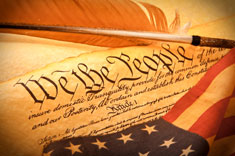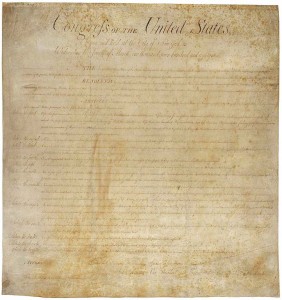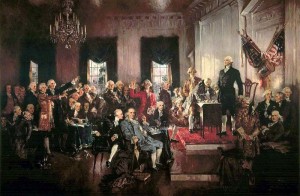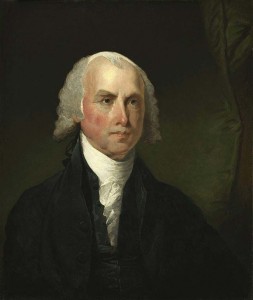| United States Constitution | |
|---|---|
 |
|
| The U.S. Constitution | |
| Preamble | |
| Articles of the Constitution | |
| I ‣ II ‣ III ‣ IV ‣ V ‣ VI ‣ VII | |
| Amendments to the Constitution | |
| Bill of Rights | |
| I ‣ II ‣ III ‣ IV ‣ V ‣ VI ‣ VII ‣ VIII ‣ IX ‣ X | |
| Additional Amendments | |
| XI ‣ XII ‣ XIII ‣ XIV ‣ XV ‣ XVI ‣ XVII ‣ XVIII ‣ XIX ‣ XX ‣ XXI ‣ XXII ‣ XXIII ‣ XXIV ‣ XXV ‣ XXVI ‣ XXVII | |
| View the Full Text | |
| Original Constitution | |
| Bill of Rights | |
| Additional Amendments |
The Bill of Rights was first submitted to Congress on August 21, 1789 by James Madison in order to alleviate the reservations harbored by the Anti-Federalists in regards to the Constitution. It consisted of 12 Amendments which would limit the powers of centralized government and protect the rights of individual citizens. Of the 12 Amendments proposed, 10 were ratified by the states and on December 15, 1791, the Bill of Rights officially became law.
Background
After the United States had won its independence from England, a unified government was needed to ensure its continued prosperity. Therefore, delegates from each of the states gathered at the Continental Congress in 1776 and began drafting what would become The Articles of Confederation. Although the articles offered some semblance of order, the role of centralized government was almost non-existent, and, as the nation amassed debt and conflicts between the states escalated, it was agreed that a Constitutional Convention would be in the best interest of the United States.
Instead of attempting to alter the existing laws, the delegates agreed to visualize and adopt an entirely new constitution which would give greater powers to the Federal Government. However, as many remembered the oppressive hand of the monarchy in England, deliberations resulted in stalemates on more than one occasion.
Federalists and Anti-Federalists
 Although it was widely acknowledged that the United States Constitution required alteration if the nation was to persevere, the level of power that would be afforded to centralized government was highly controversial. Members of the Convention who called for a strong central power were known as Federalists while those who were wary of a nation-encompassing government were known as Anti-Federalists. While the Federalists advocated for the Executive, Legislative, and Judicial branches, Anti-Federalists feared that too much power was being allotted and that the President would become a King. As the delegates continued to hold fast to their positions, there seemed little hope of a compromise.
Although it was widely acknowledged that the United States Constitution required alteration if the nation was to persevere, the level of power that would be afforded to centralized government was highly controversial. Members of the Convention who called for a strong central power were known as Federalists while those who were wary of a nation-encompassing government were known as Anti-Federalists. While the Federalists advocated for the Executive, Legislative, and Judicial branches, Anti-Federalists feared that too much power was being allotted and that the President would become a King. As the delegates continued to hold fast to their positions, there seemed little hope of a compromise.
Proposal of the Bill
 As the debate over the new constitution continued, some delegates proposed including a list of individual rights that could not be infringed upon by the Federal Government. The suggestion appealed to many of the Anti-Federalists whose stipulations with the new constitution stemmed from fear of the potential loss of civil liberties. However, as the nation was becoming increasingly unstable, it was imperative that the Constitution be ratified as soon as possible.
As the debate over the new constitution continued, some delegates proposed including a list of individual rights that could not be infringed upon by the Federal Government. The suggestion appealed to many of the Anti-Federalists whose stipulations with the new constitution stemmed from fear of the potential loss of civil liberties. However, as the nation was becoming increasingly unstable, it was imperative that the Constitution be ratified as soon as possible.
With the consensus that a second Convention would take place to include the Bill of Rights, the Constitution was ratified and passed into law on March 4, 1789.
Madison
 James Madison was largely responsible for the first draft of the Bill of Rights and drew his inspiration from various sources including the English Bill of Rights, Virginia’s Declaration of Rights, and the ideas of John Locke. After submitting the formal draft to Congress, the original 17 Amendments were replaced with a 12 Amendment version. The states agreed and adopted 10 of the proposed Amendments into the Constitution on December 15, 1791.
James Madison was largely responsible for the first draft of the Bill of Rights and drew his inspiration from various sources including the English Bill of Rights, Virginia’s Declaration of Rights, and the ideas of John Locke. After submitting the formal draft to Congress, the original 17 Amendments were replaced with a 12 Amendment version. The states agreed and adopted 10 of the proposed Amendments into the Constitution on December 15, 1791.
The Amendments
The 10 Amendments that were added to the Constitution all dealt with the civil liberties of the individual.
The First Amendment sanctioned the freedoms of religion, speech, press, and the right to assemble and petition peacefully.
The Second and Third Amendments protected the rights of the people in relation to bearing arms and quartering troops in war or peace. They stated that citizens were allowed firearms to protect themselves and their property and that no one could be forced to house soldiers against their will.
The Fourth through Sixth Amendments dealt with the restrictions of the law in regards to criminal convictions. The Fourth Amendment sanctioned privacy and barred the law from searching private property without just cause. The Fifth Amendment offered protection from self-incrimination and retrials. The Sixth Amendment built upon the Fifth and granted the prosecuted a public trial by jury and the right to face their accusers.
The Seventh Amendment concerned common law, stating that civil cases would retain the right to a trial by jury and could not be retried by another court of law.
The Eight Amendment prohibited cruel and unusual punishment as well as excessive fines or bail.
The Ninth Amendment forbade the manipulation of the other Amendments for the purpose of denying rights and stated that rights outside of the ones listed should still be upheld.
The Tenth Amendment specifies that the rights that are not granted to the Federal Government, nor prohibited to State Government, remain in the power of the States and people.
The Bill of Rights Today
Though it was drafted over 200 years ago, the Bill of Rights is still an essential piece of law for the United States and, since its ratification in the late 1700s, 17 more Amendments have been passed into law. The Constitution, Bill of Rights, and ensuing additional Amendments were drafted to be a single, malleable document, a quality that has allowed them to remain relevant throughout various social, political, and economic changes.